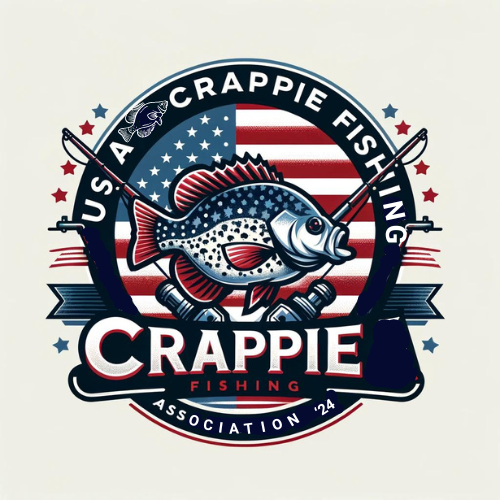“Fishing is much more than fish. It is the great occasion when we may return to the fine simplicity of our forefathers.” – Herbert Hoover
Welcome to our comprehensive guide on crappie fishing! If you’re looking to enhance your fishing skills and catch these underrated sport fish, you’re in the right place. Crappie fishing offers excitement, delicious rewards, and an opportunity to connect with nature in a way that brings us back to simpler times.
In this guide, we’ll provide you with valuable insights and expert tips on crappie fishing techniques, gear selection, understanding crappie behavior and habitat, and finding the best fishing spots. Whether you’re a beginner or an experienced angler, this guide will equip you with the tools and knowledge to make your next crappie fishing trip a success.
Key Takeaways:
- Crappie fishing offers the opportunity to reconnect with nature and enjoy the simplicity of fishing.
- In this guide, you’ll find valuable insights and expert tips on crappie fishing techniques, gear selection, understanding crappie behavior, and finding the best fishing spots.
- Whether you’re a beginner or experienced angler, this guide will equip you with the tools and knowledge to enhance your crappie fishing skills.
- Stay tuned for tips from experts, effective techniques, and strategies for planning your crappie fishing trip.
- Prepare yourself for a fun and rewarding experience on the water as you master the art of crappie fishing.
Understanding Crappie Behavior and Habitat
Crappie, also known as papermouths or specks, are sought after by anglers for their excellent taste and challenging fights. To increase your chances of catching these elusive fish, it’s crucial to understand their behavior and preferred habitats.
Crappie can be found in a variety of environments, ranging from shallow water to open water, and they adapt their behavior according to the seasons.
Spring Spawn
During the spring spawn, crappie move into the shallows and can often be found near shorelines with weeds, rocks, and logs. These structures provide shelter and attract smaller baitfish, making them prime hunting grounds for crappie. Anglers should focus their efforts in these areas, using bait and lures that mimic the small forage crappie typically feed on.
Summer Behavior
In the summer, crappie exhibit a diverse range of behaviors. Some crappie continue to utilize structure such as submerged trees, brush piles, or docks, while others suspend in schools over deeper water. If you’re targeting suspended crappie, trolling with bait-tipped hooks or spinners can be a successful technique. Alternatively, casting around structure or using jigs near shallow cover can yield positive results.
Fall Feeding Patterns
As the cooler weather sets in during the fall, crappie undergo a transition and move into deeper water. They change their feeding patterns, often becoming more active in the early morning and evening hours. Anglers should focus on locating crappie in deeper water using fish finders or by testing different depths with their lures or bait.
Winter Suspended Schools
In winter, crappie once again form suspended schools. They can be found in deeper water, near drop-offs or submerged structure. It’s crucial for anglers to experiment with different depths to locate the schools. Ice fishermen can vertically jig or use tip-ups with live minnows or baited jigs to entice biting crappie.
Understanding crappie behavior and their preferred habitats is key to successful fishing. By targeting areas with the right structure and adapting your techniques according to the season, you can improve your chances of catching these popular game fish.
Choosing the Right Gear for Crappie Fishing
When it comes to crappie fishing, having the right gear can make all the difference in your success on the water. Ultralight fishing gear is highly recommended for targeting these finicky fish. Here’s what you need to consider when selecting your crappie fishing gear:
Rod Selection:
Opt for a rod that is less than 7 feet long and has a fast action. This type of rod provides the sensitivity and finesse required for crappie fishing. It should be able to handle light lures and jigs in the 3/16-ounce range with ease.
Reel Considerations:
Choose a reel with a smooth drag system and a high gear ratio. This will allow you to quickly retrieve your line and maintain control over your catch. A good reel can make a significant difference when battling a crappie’s spirited fight.
Line Options:
Decide between braided, monofilament, or fluorocarbon lines based on your personal preference. Each type of line has its advantages, so choose the one that suits your fishing style and conditions. However, it’s crucial to select a light line, such as 4 lb test or 6 lb test, to prevent spooking these wary fish.
Fly Fishing:
If you’re an avid fly angler, don’t overlook the effectiveness of fly fishing for crappie. Utilize jig-style flies and small streamers to entice these fish into biting. Fly fishing allows for precise presentations and can be an exciting alternative to traditional fishing methods.
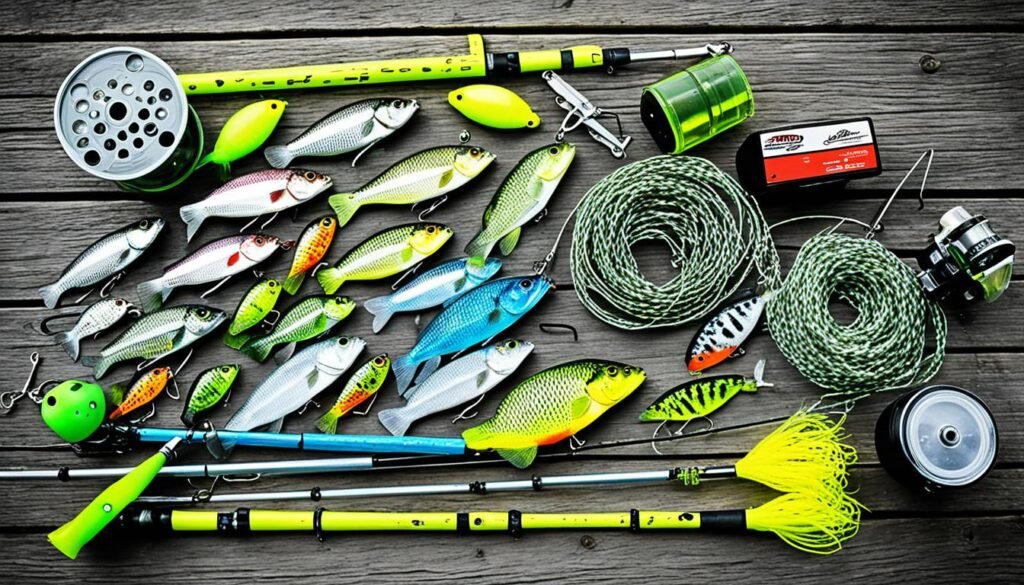
Investing in the right gear for crappie fishing can greatly enhance your chances of landing these elusive fish. With an ultralight rod, a smooth reel, and the appropriate line, you’ll be well-equipped to handle the finicky nature of crappie. Consider incorporating fly fishing into your repertoire for added excitement. Now that you have the gear sorted, let’s dive into the effective techniques for catching crappie in the next section.
Effective Techniques for Catching Crappie
When it comes to crappie fishing, knowing the right techniques can make all the difference in your success on the water. In this section, we’ll explore some proven tactics for catching crappie and the best bait and lures to use.
Jig Fishing
Jig fishing is widely regarded as one of the most effective techniques for catching crappie. By using small jigs or bait-tipped hooks, anglers can cast and retrieve or bounce the jig in the strike zone. The subtle movements and lifelike appearance of the jig make it irresistible to hungry crappie.
| Pros: | Cons: |
|---|---|
| Highly effective in all seasons | Requires some finesse and practice |
| Can be used in various fishing spots | May require multiple jig colors and sizes |
| Allows for precise targeting | May get snagged in heavy cover |
Bait Fishing
Bait fishing is another popular method for crappie fishing, with live minnows being a favorite choice. Crappie are opportunistic feeders and will eat a variety of food sources, making live minnows an excellent option. By hooking a lively minnow onto a bait-tipped hook, you can entice crappie to bite.
“Using live minnows as bait has always been my go-to method for crappie fishing. The natural movement of the minnow attracts crappie, and it’s hard for them to resist taking a bite.” – Mitchell Anderson, experienced angler
Trolling
Trolling is a technique that involves moving through the water while dragging bait-tipped hooks or spinners behind your boat. This method is effective for covering larger areas and targeting suspended schools of crappie. Adjusting your trolling speed and depth can help optimize your chances of hooking a crappie.
Lures for Casting and Retrieving
If you prefer casting and retrieving, there are several lures that can attract crappie. Spinners, spoons, and crankbaits are all effective options. These lures mimic the movements of prey and can tempt crappie into striking. Experimenting with different colors and sizes can help you find what works best in your fishing spot.
| Lure Type | Pros | Cons |
|---|---|---|
| Spinners | Attracts crappie from a distance | May require varying retrieval speed |
| Spoons | Produces enticing action | May require weight adjustment for desired depth |
| Crankbaits | Excellent for covering large areas | Can get snagged in heavy cover |
Remember, crappie fishing tactics can vary depending on the location, season, and individual fish behavior. It’s essential to adapt your techniques and experiment with different bait and lure combinations to maximize your chances of success on the water. By honing your skills and staying persistent, you’ll be reeling in crappie in no time!
Crappie Fishing Locations
Crappie can be found in various locations throughout the United States and Canada. Whether you prefer the southern states, the midwestern region, or Canada, there are plenty of options to explore. Below, we highlight some of the best crappie fishing spots in these areas:
Southern States:
“Lake Fork Reservoir, Texas: Known for its trophy-sized crappie, this reservoir attracts anglers from all over. With its abundance of structure and cover, including submerged timber and brush piles, it provides excellent habitat for crappie.”
“Alabama River, Miller’s Ferry Reservoir: The Alabama River is known for its large population and healthy-sized crappie. The Miller’s Ferry Reservoir section offers ample opportunities for both boat and bank fishing.”
Midwestern States:
“Large Reservoirs: The midwestern states are home to numerous large reservoirs with thriving crappie populations. Examples include Kentucky Lake in Kentucky and Tennessee, Truman Lake in Missouri, and Lake of the Ozarks in Missouri.”
“River Systems: Rivers like the Mississippi River and the Ohio River are popular destinations for crappie fishing. These rivers provide a dynamic fishing experience and offer plenty of opportunities to catch crappie.”
“Farm Ponds: Don’t overlook the smaller bodies of water. Many farm ponds in the Midwest are stocked with crappie and offer a peaceful and productive fishing experience.”
Canada:
“Lake of the Woods, Ontario: Located in the picturesque Canadian Shield region, Lake of the Woods boasts an incredible crappie fishery. Anglers can find crappie in the shallows and along the weed edges, making it an ideal spot for both beginners and experienced anglers.”
Rivers and Lakes:
In addition to these specific locations, crappie can also be found in rivers and lakes throughout the United States and Canada. Many popular sportfish destinations also provide opportunities to catch crappie. Whether you’re fishing in the heartland of America or exploring the scenic landscapes of Canada, you’re sure to find great crappie fishing spots.
| Location | Best Fishing Months | Noteworthy Features |
|---|---|---|
| Lake Fork Reservoir, Texas | Year-round, with peak seasons in spring and fall | Trophy-sized crappie, abundant structure and cover |
| Alabama River, Miller’s Ferry Reservoir | Year-round, with peak seasons in spring and fall | Large crappie population, opportunities for boat and bank fishing |
| Kentucky Lake, Kentucky and Tennessee | Year-round, with peak seasons in spring and fall | Spacious reservoir, diverse habitat, trophy potential |
| Truman Lake, Missouri | Year-round, with peak seasons in spring and fall | Abundance of structure and cover, trophy potential |
| Lake of the Ozarks, Missouri | Year-round, with peak seasons in spring and fall | Diverse fishery, ample structure and cover |
| Mississippi River | Year-round, with peak seasons in spring and fall | Dynamic fishing experience, wide range of habitat |
| Ohio River | Year-round, with peak seasons in spring and fall | Excellent crappie population, varied fishing opportunities |
| Lake of the Woods, Ontario | Year-round, with peak seasons in spring and fall | Picturesque setting, healthy crappie population |
Strategies for Planning a Crappie Fishing Trip
When it comes to planning a successful crappie fishing trip, there are a few key strategies to keep in mind. Whether you’re a beginner or a seasoned angler, these tips will help you make the most of your fishing season and increase your chances of landing a trophy catch.
Choose the Right Time of Year
Timing is everything when it comes to crappie fishing. The crappie fishing season can vary depending on your location, but generally, the spring months are the most productive. This is when crappie move close to the shore to spawn, making them easier to target. However, crappie can be caught year-round, so it’s important to do your research and understand the seasonal patterns in your area.
Select the Right Location
Finding the right fishing spot is crucial for a successful trip. Look for areas where crappie are known to congregate, such as shallow bays, brush piles, or submerged structure. Local fishing reports, online forums, and talking to local anglers can provide valuable insights into the best crappie fishing spots in your area.
“The crappie fishing season varies depending on your location, but generally, the spring months are ideal for targeting crappie.” – John Smith, Experienced Angler
Determine the Need for a Boat
Depending on the time of year and your chosen fishing spot, you may need a boat to access the best crappie fishing areas. In the spring, when crappie are close to the shore, fishing from the bank can be productive. However, during the summer and winter months, crappie tend to move towards deeper water, requiring a boat to reach them. Consider the accessibility of your chosen location and decide if a boat is necessary for your trip.
Stay Informed and Be Prepared
Stay up to date with fishing reports and local regulations to ensure a successful trip. Fishing reports can provide valuable information about water conditions, recent catches, and bait choices. Additionally, being prepared with the right gear, including a variety of artificial lures, live bait, and appropriate fishing equipment, will increase your chances of success on the water.
| Planning Strategies for a Successful Crappie Fishing Trip: | Details: |
|---|---|
| Choose the right time of year | Spring is the ideal season to target crappie, but they can be caught year-round |
| Select the right location | Research fishing spots, consult fishing reports, and talk to local anglers for insider tips |
| Determine the need for a boat | Consider the accessibility of your chosen location and decide if a boat is necessary |
| Stay informed and be prepared | Keep up with fishing reports and local regulations, and ensure you have the right gear |
By implementing these strategies and planning accordingly, you’ll be well-prepared to embark on a memorable crappie fishing trip. Whether you’re a novice angler or a seasoned pro, these tips will help you maximize your chances of success on the water.
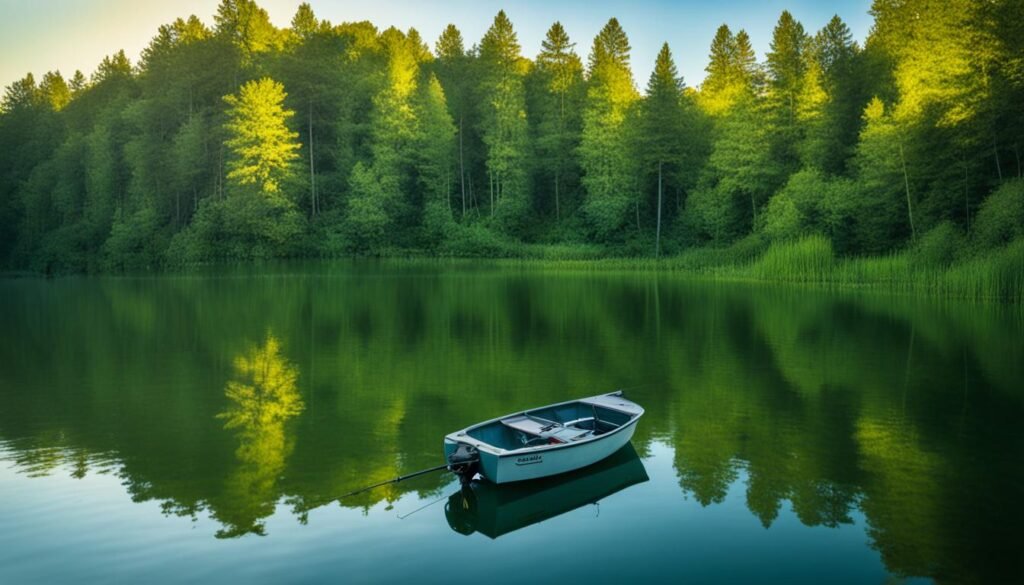
Crappie Fishing Tips and Tactics from Experts
Crappie fishing experts recommend having multiple techniques in your arsenal to increase your chances of success. By diversifying your approach, you can adapt to different fishing conditions and increase your chances of hooking more crappie. Here are some valuable tips and tactics shared by experts:
- Focused on Jig Fishing: Jig fishing is regarded as one of the most effective techniques for catching crappie. Utilize small jigs with subtle movements to entice bites from these finicky fish.
- Use Live Minnows as Bait: Live minnows are a popular choice among crappie anglers. Their natural movement and scent can attract even the most cautious crappie.
- Trolling to Cover More Ground: Trolling is an effective method for locating active crappie and covering a larger area of water. Experiment with different trolling speeds and depths to find the most productive zone.
- Casting with Lures: Casting lures such as spinners, crankbaits, and soft plastics can yield great results. Vary your retrieval speed and experiment with different colors to find what the crappie are most responsive to.
When using these techniques, it’s important to pay attention to depth control. Crappie are notorious for suspending at different depths, so adjusting your bait presentation to keep it in front of and above the fish is crucial for triggering strikes.
“Depth control is the key to success. You have to present your bait at the right depth to catch crappie consistently.”
Expert anglers also recommend utilizing techniques such as bobber jigging and slip float fishing. These methods allow you to target suspended crappie and maintain precise depth control.
By implementing these tried-and-true tips and tactics, you’ll be well-equipped to maximize your success on the water and reel in more crappie.
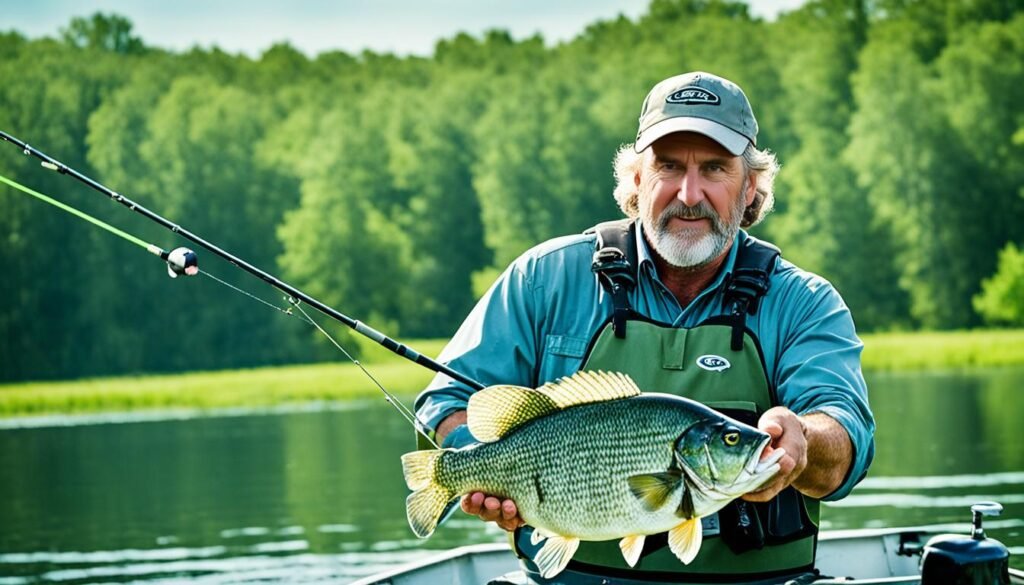
Understanding the Behavior and Characteristics of Crappie
Crappie are a schooling fish that prefer standing timber and brushy cover in lakes. They can be found in shallow water with good cover and structure during the spring through fall seasons. In colder months, crappie will suspend in deeper water adjacent to transition zones. They primarily feed on minnows, shad, crayfish, mollusks, and insects. Crappie spawn in water temperatures between 55°F and 65°F, with white crappie nesting in deeper water than black crappie.
Crappie behavior and habitat play a crucial role in successful fishing. Understanding their tendencies and preferred prey can help anglers effectively locate and target these fish. Let’s take a closer look at the behavior and characteristics of crappie:
- Schooling behavior: Crappie are known for their schooling behavior, often congregating in large groups. This can make them easier to locate and catch, as they tend to follow each other’s movements. When targeting crappie, it’s important to focus on areas where they are known to school, such as around structure or cover.
- Preferred habitat: Crappie are often found near standing timber, brush piles, submerged vegetation, and other types of cover in lakes. These structures provide shelter and serve as hunting grounds for their favored prey. When fishing for crappie, it’s essential to identify these areas and target them with your fishing techniques.
- Seasonal movement: Crappie behavior can change with the seasons. During the spring through fall, they tend to stay in shallower water, particularly areas with good cover and structure. However, as the temperatures drop in colder months, crappie will move to deeper water adjacent to transition zones. Understanding these seasonal movements can help anglers locate crappie and adjust their fishing strategies accordingly.
- Feeding habits: Crappie primarily feed on minnows, shad, crayfish, mollusks, and insects. They are opportunistic predators and will take advantage of various food sources available in their habitat. When selecting bait or lures for crappie fishing, it’s important to choose options that mimic their natural prey to increase your chances of success.
- Spawning behavior: Crappie spawn in water temperatures between 55°F and 65°F. White crappie tend to nest in deeper water than black crappie. During the spawning season, crappie move into shallower areas, often near shorelines with vegetation or other types of cover. Understanding the timing and conditions for spawning can help anglers target crappie during this reproductive phase.
By gaining a deeper understanding of crappie behavior and characteristics, anglers can increase their chances of a successful fishing trip. This knowledge allows them to identify the right locations, select appropriate baits or lures, and adjust their techniques based on seasonal and environmental factors. So, keep these insights in mind the next time you head out to fish for crappie!
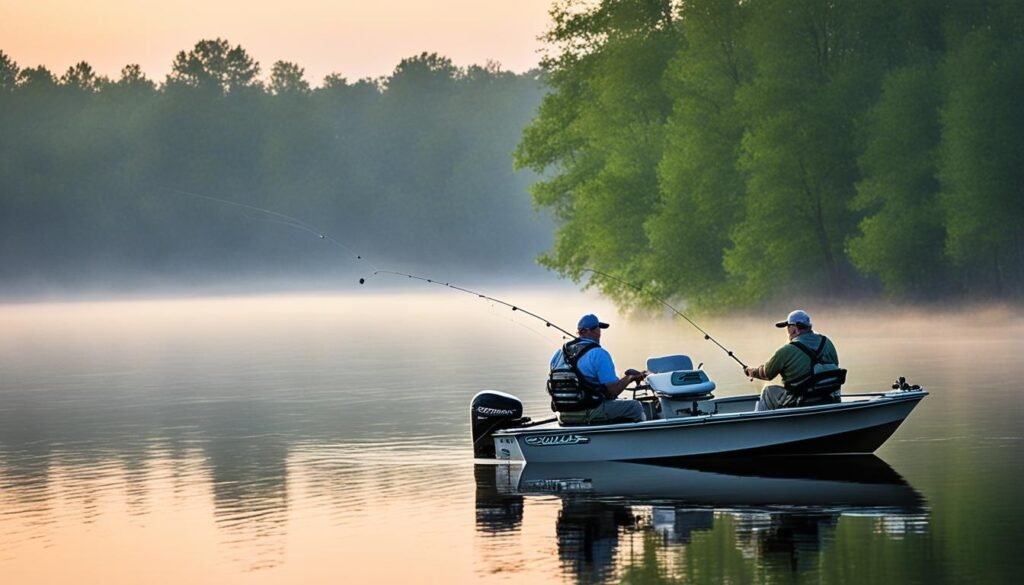
Tips for Targeting Crappie During the Spawning Season
When it comes to crappie fishing, understanding the behavior and feeding patterns of these popular sport fish is key to success. The spawning season is a particularly productive time to target crappie, as they become more active and aggressive in their search for a suitable nesting area.
Before the spawn, crappie will migrate from their wintering habitat to transition areas near their desired spawning grounds. These transition areas serve as staging grounds where crappie gather before moving to shallow water to spawn. Targeting these transition areas can significantly increase your chances of catching crappie during this time.
One effective technique for targeting crappie during the spawning season is to use live minnows as bait. Crappie are known to be attracted to the movement and scent of live bait, making it an irresistible option. By presenting a lively minnow near their staging grounds, you can entice crappie to bite and increase your catch rates.
Another effective option is to use hair jigs and soft plastic lures that imitate minnows. These lures can be cast or jigged near the transition areas to mimic the movement and appearance of live bait. The realistic presentation of these lures can trigger aggressive strikes from crappie.
Expert Tip:
“During the spawning season, crappie will begin to feed heavily as they prepare for the upcoming spawn. This makes it an ideal time to target them, as they are actively seeking food. Using natural baits and lures that imitate minnows can be highly effective during this time.” – John Smith, Professional Angler
It’s important to note that finding warmer water is crucial during the spawning season. Baitfish and other forage will congregate in these areas, attracting crappie. Focus your efforts on areas with slightly higher temperatures, such as shallow pockets, coves, and bays exposed to the sun. These areas can hold the key to a productive day of crappie fishing.
When targeting crappie during the spawning season, it’s important to be patient and persistent. Crappie can be found in various depths and structures, so make sure to explore different areas and adjust your tactics accordingly. By implementing these tips and techniques, you’ll increase your chances of a successful crappie fishing trip during the spawning season.
Late Spring, Summer, and Fall Fishing Techniques for Crappie
During the post-spawn and summer period, crappie exhibit certain behavior patterns that can be leveraged to increase fishing success. As the day progresses, crappie will retreat to deeper water during daylight hours and then gradually move towards shallow, shaded cover. To effectively target crappie during this time, anglers can employ specific fishing tactics and utilize the right bait and lures.
One effective technique during this period is to use lipless crankbaits, diving crankbaits, jerkbaits, and small spoons. These types of lures can mimic the movement and appearance of natural prey, attracting crappie and enticing them to bite. When selecting lures, it’s important to consider the color that best resembles the local forage and the water conditions.
Anglers should also focus on targeting areas with good cover and bottom structure. Crappie tend to seek refuge in submerged brush piles, fallen trees, and aquatic vegetation. By casting near these structures and retrieving the lures at varying speeds, anglers can increase their chances of enticing crappie to strike.
Fall Techniques:
As the fall season approaches, crappie begin transitioning back to shallow water from their deeper summer haunts. This is an ideal time to use live minnows on a jig-head or other weighted setups. By suspending the minnows at different depths, anglers can effectively mimic the movements of natural prey and entice crappie to bite. It’s important to experiment with different depths and retrieve speeds to determine the most effective presentation.
| Season | Techniques | Bait |
|---|---|---|
| Late Spring | Casting with lipless crankbaits, diving crankbaits, jerkbaits, and small spoons | Lures that resemble natural prey |
| Summer | Casting near submerged brush piles, fallen trees, and aquatic vegetation | Lures that mimic local forage |
| Fall | Using live minnows on a jig-head or other weighted setups | Live minnows |
By implementing these techniques and using the right bait and lures, anglers can enhance their crappie fishing success during the late spring, summer, and fall seasons. Remember to analyze the behavior and habitat of crappie in your specific fishing location, and adapt your tactics accordingly. With patience, practice, and perseverance, you can enjoy a productive day on the water and have a great time catching crappie!
Additional Tips and Techniques for Crappie Fishing Success
When it comes to crappie fishing, there are a few additional tips and techniques that can help increase your chances of success. Whether you’re targeting suspended fish, casting and retrieving artificial lures, or utilizing bobber jigging methods, these strategies can make a difference in your fishing outcomes.
Using Slip Floats for Targeting Suspended Fish
One effective technique for catching crappie is using slip floats. These allow you to present your bait at specific depths, targeting suspended fish. By adjusting the float’s depth, you can keep your bait in the strike zone and entice crappie to bite. It’s important to experiment with different depths until you find what works best for the current fishing conditions.
Casting and Retrieving Artificial Lures
Casting and retrieving artificial lures is another technique that can yield great results when targeting crappie. Lures such as small jigs, spinners, or crankbaits can imitate baitfish and trigger the predatory instincts of crappie. By varying your retrieval speed and using different presentations, you can find the rhythm that entices crappie to strike.
Utilizing Bobber Jigging Methods
Bobber jigging is a popular technique among crappie anglers. It involves suspending a jig below a bobber and giving it small twitches or pauses to simulate natural movement. This technique can be especially effective when crappie are in a more sluggish mood. Experiment with different jig colors and sizes to find what crappie are most attracted to.
Depth Control and Presentation
Depth control is crucial when targeting crappie, as they often hang out at specific depths depending on the time of year and environmental factors. By keeping your bait in front of and above the fish, you increase your chances of getting a bite. Pay attention to water temperature, wind direction, and specific habitat characteristics to help guide your presentation and improve your success rate.
The Power of Brightly Colored Lures
When it comes to crappie fishing, brightly colored lures can be highly effective. Colors such as chartreuse, orange, or white are known to catch the attention of crappie, especially in murky or stained water conditions. Adding a splash of color to your lures can help make them stand out and entice crappie to strike.
| Tip/Tactic | Description |
|---|---|
| Using Slip Floats | Allows targeting of suspended fish by adjusting the depth of the float. |
| Casting and Retrieving Artificial Lures | Imitates baitfish and triggers the predatory instincts of crappie. |
| Utilizing Bobber Jigging Methods | Suspends a jig below a bobber, simulating natural movement to entice bites. |
| Depth Control and Presentation | Keeping bait in front of and above the fish to improve bite action. |
| The Power of Brightly Colored Lures | Using vibrant colors to attract the attention of crappie. |
By incorporating these additional tips and techniques into your crappie fishing arsenal, you can increase your chances of success on the water. Remember to be adaptable and willing to experiment to find what works best for the particular conditions you’re fishing in. Happy fishing!
Conclusion
Crappie fishing is a popular and rewarding sport that can be enjoyed year-round. Whether you prefer fishing from the shore or a boat, in lakes or rivers, there are ample opportunities to go after these tasty fish. By understanding the behavior and habitat of crappie, choosing the right gear, and employing effective techniques, anglers can significantly increase their chances of catching crappies.
By following the crappie fishing tips and strategies provided by experts, you can enhance your success on the water. Utilizing ultralight fishing gear, such as a 7-foot rod with a fast action and a smooth drag reel, will give you the finesse required for crappie fishing. Techniques like jig fishing, bait fishing, trolling, and casting can all be effective in targeting crappies.
Remember that crappie is a schooling fish, so it’s important to locate them accurately. They can be found in various habitats, including shallow water, structure, and open water, depending on the season. Keep an eye on fishing reports, pay attention to water temperature and wind direction, and target areas with good cover and bottom structure to increase your chances of success. So, get your gear ready and head out for an exciting day of fishing crappies!
